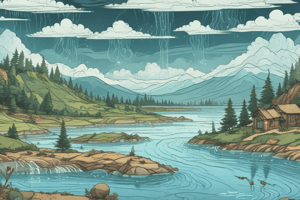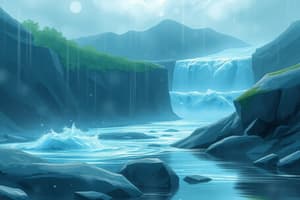Podcast
Questions and Answers
On a day when the temperature is 20°C, if the absolute humidity is 7.5 g water/kg air, what is the relative humidity?
On a day when the temperature is 20°C, if the absolute humidity is 7.5 g water/kg air, what is the relative humidity?
50%
Explain how a cold front leads to precipitation.
Explain how a cold front leads to precipitation.
A cold front pushes under a mass of warm, moist air, forcing it upwards. As the warm air rises, it cools, and the moisture condenses, leading to precipitation.
Describe how a mountain range affects precipitation patterns, creating both wet and dry areas.
Describe how a mountain range affects precipitation patterns, creating both wet and dry areas.
As air rises over the windward side of a mountain, it cools and releases moisture as precipitation. On the leeward side, the air descends, warms, and dries, creating a rain shadow with less precipitation.
Explain why the Sahara Desert has very low precipitation, referencing the ocean current and rain shadow effect.
Explain why the Sahara Desert has very low precipitation, referencing the ocean current and rain shadow effect.
How do wind and ocean currents contribute to distributing heat from tropical to temperate regions?
How do wind and ocean currents contribute to distributing heat from tropical to temperate regions?
Besides a mountain, what other mechanism can force air to move upwards in altitude?
Besides a mountain, what other mechanism can force air to move upwards in altitude?
If the air temperature is zero, what is the maximum absolute humidity possible?
If the air temperature is zero, what is the maximum absolute humidity possible?
Explain why tropical regions are generally hotter than temperate regions, and relate it to the angle of the sun's rays.
Explain why tropical regions are generally hotter than temperate regions, and relate it to the angle of the sun's rays.
Explain why the relationship between pressure and temperature is linear in Celsius but directly proportional in Kelvin.
Explain why the relationship between pressure and temperature is linear in Celsius but directly proportional in Kelvin.
Describe the chain of events in a typical sea breeze formation, starting with the temperature difference between land and ocean.
Describe the chain of events in a typical sea breeze formation, starting with the temperature difference between land and ocean.
How does decreasing the volume of a gas affect its pressure, and what is the scientific explanation for this phenomenon?
How does decreasing the volume of a gas affect its pressure, and what is the scientific explanation for this phenomenon?
Explain how increased melanin production helps protect the skin from the sun's harmful rays.
Explain how increased melanin production helps protect the skin from the sun's harmful rays.
What is the role of ozone (O3) in the atmosphere, and what class of chemicals is known for destroying it?
What is the role of ozone (O3) in the atmosphere, and what class of chemicals is known for destroying it?
How does the absorption of visible radiation differ from the absorption of infrared radiation in terms of their effects on matter?
How does the absorption of visible radiation differ from the absorption of infrared radiation in terms of their effects on matter?
Describe the greenhouse effect and how it influences the temperature of the Earth's atmosphere.
Describe the greenhouse effect and how it influences the temperature of the Earth's atmosphere.
Explain the relationship between air pressure and wind, and specifically, what pressure conditions lead to the formation of typhoons?
Explain the relationship between air pressure and wind, and specifically, what pressure conditions lead to the formation of typhoons?
Explain why using the Kelvin scale is advantageous when studying gas behavior compared to using the Celsius scale.
Explain why using the Kelvin scale is advantageous when studying gas behavior compared to using the Celsius scale.
Describe how the continuous collisions of gas molecules result in measurable pressure. Briefly describe what is happening at the atomic level.
Describe how the continuous collisions of gas molecules result in measurable pressure. Briefly describe what is happening at the atomic level.
If you have a closed container of gas at a constant volume, describe the relationship between the gas's pressure and temperature (in Kelvin).
If you have a closed container of gas at a constant volume, describe the relationship between the gas's pressure and temperature (in Kelvin).
Explain in your own words why water boils at a lower temperature on the top of Mount Everest compared to at sea level.
Explain in your own words why water boils at a lower temperature on the top of Mount Everest compared to at sea level.
In the "can crush" demonstration, water is boiled in a can before it's sealed and plunged into ice water. With that information plus the information given to you, explain why the can gets crushed.
In the "can crush" demonstration, water is boiled in a can before it's sealed and plunged into ice water. With that information plus the information given to you, explain why the can gets crushed.
Argon is an inert noble gas used in welding. At cryogenic temperatures, what physical state will argon likely be in, and why?
Argon is an inert noble gas used in welding. At cryogenic temperatures, what physical state will argon likely be in, and why?
Besides acting as a greenhouse gas required by plants for photosynthesis, name another role that carbon dioxide gas plays in the atmosphere.
Besides acting as a greenhouse gas required by plants for photosynthesis, name another role that carbon dioxide gas plays in the atmosphere.
CFCs (chlorofluorocarbons) were once commonly used in refrigerants but are now banned. Explain their harmful effect in the atmosphere, and identify which trace gas they primarily damage.
CFCs (chlorofluorocarbons) were once commonly used in refrigerants but are now banned. Explain their harmful effect in the atmosphere, and identify which trace gas they primarily damage.
Flashcards
Cryogenics
Cryogenics
The production and study of materials at extremely low temperatures.
Oxygen gas
Oxygen gas
Gas that makes up about 19% of the Earth's atmosphere.
Nitrogen gas
Nitrogen gas
Gas that makes up about 80% of the Earth's atmosphere.
Kelvin scale
Kelvin scale
Signup and view all the flashcards
Gas pressure
Gas pressure
Signup and view all the flashcards
Boiling point
Boiling point
Signup and view all the flashcards
Can crush cause
Can crush cause
Signup and view all the flashcards
Proportional relationship
Proportional relationship
Signup and view all the flashcards
Pressure and Temperature (Kelvin)
Pressure and Temperature (Kelvin)
Signup and view all the flashcards
Pressure vs. Volume
Pressure vs. Volume
Signup and view all the flashcards
What Causes Wind?
What Causes Wind?
Signup and view all the flashcards
Sea Breeze Creation
Sea Breeze Creation
Signup and view all the flashcards
What Causes Typhoons?
What Causes Typhoons?
Signup and view all the flashcards
Melanin and UV Protection
Melanin and UV Protection
Signup and view all the flashcards
Ozone Layer's Role
Ozone Layer's Role
Signup and view all the flashcards
Greenhouse Effect
Greenhouse Effect
Signup and view all the flashcards
Humidity
Humidity
Signup and view all the flashcards
Absolute humidity
Absolute humidity
Signup and view all the flashcards
Relative humidity
Relative humidity
Signup and view all the flashcards
Wind
Wind
Signup and view all the flashcards
Rain Shadow
Rain Shadow
Signup and view all the flashcards
Causes of Rising Air
Causes of Rising Air
Signup and view all the flashcards
Why are tropics hotter?
Why are tropics hotter?
Signup and view all the flashcards
Heat distribution methods
Heat distribution methods
Signup and view all the flashcards
Study Notes
- Cryogenics involves the production and behavior of materials at very low temperatures.
- Nitrogen and oxygen gases will condense into liquid form at cryogenic temperatures.
- Nitrogen gas condenses at approximately -183°C.
- Oxygen gas condenses at approximately -196°C.
Composition of Air
- Oxygen gas comprises about 19% of the atmosphere.
- Nitrogen gas makes up about 80% of the atmosphere.
- Carbon dioxide is present in trace amounts and serves as a greenhouse gas, a product of combustion, required by the plants for photosynthesis.
- Water vapor is found in trace amounts and is responsible for precipitation.
- Ozone absorbs UV radiation and can be destroyed by chemical pollutants such as CFCs.
- Methane is a highly potent greenhouse gas.
Kelvin Scale
- The Kelvin scale is an absolute temperature scale, where 0 K is absolute zero.
- A temperature in Kelvin is 273.15 more than its equivalent in Celsius.
Gas Pressure
- Gas pressure arises from the continuous collisions of gas molecules with the walls of their container.
- Fast-moving gas molecules exert force upon colliding with container walls.
- The collective force from these collisions results in measurable pressure.
Can Crush Demonstration
- When boiled, the steam displaces the air in the container above the water.
- Submerging the can in cold water causes the can to collapse as the air pressure outside the can becomes significantly stronger than the air pressure inside the can.
Pressure and Temperature
- Temperature in Kelvin increases, pressure increases proportionally, assuming volume is constant.
Pressure and Volume
- Volume decreases, pressure increases, and vice versa
- Decreasing volume leads to increased collision frequency due to less space for gas molecules to move.
- Doubling the volume cuts the pressure in half.
Celsius Scale
- While increasing temperature increases pressure, it's not strictly proportional because the scale shifts.
Sea Breeze
- During the day, land heats up more quickly than the ocean.
- Warm air over the land rises, creating a low-pressure area.
- Cooler, denser air from the ocean moves in to replace the rising warm air, creating a breeze from the sea to the land.
Wind
- Wind is created as warm air above land expands and rises, which causes heavier, cooler air to rush in and take its place.
Typhoons
- Typhoons are caused by air rushing in towards a low-pressure area.
UV Radiations
- UV-B and UV-C are the most dangerous
- Ozone in the atmosphere acts as the main defense against harmful UV radiation.
- CFCs are gases that can destroy the ozone layer and were used in air conditioners.
- Visible radiation represents the light spectrum and is absorbed or heats up non-transparent surfaces it hits
- Infrared radiation can be felt as heat
- The greenhouse effect is when infrared radiation warms the atmosphere around the earth.
Humidity
- Absolute humidity is the water vapor in the air measured in in grams of water per kg of air
- Relative humidity is the,
- (Absolute Humidity in the air / Max absolute humidity) x 100
Precipitation
- Most precipiation occurs on the mountain
- Least precipitation occurs on the leeward side which creates rain shadow because the air has already lost most of its moisture
Altitude
- Physical landforms like hills or mountains can force air to rise.
- Denser cold air can push warmer, more humid air upwards, causing it to rise.
Sahara Desert
- The air above the cold current Sahara desert cant carry much water, so there is no precipitation
- An area can have low precipitation as a result of being in a "rain shadow"
Australia
- The East Coast of Australia is influenced by the warm East Australian Current, which brings warm, moist air from the ocean leading to rain
- The West Coast is affected by the cold West Australian Current, which brings cool, dry air, reducing evaporation and leading to low rainfall.
Studying That Suits You
Use AI to generate personalized quizzes and flashcards to suit your learning preferences.




